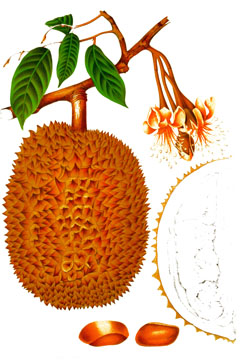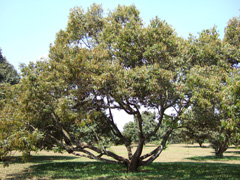 |
|
https://edibleplants.org/ |
 |
| https://edibleplants.org/ |
Translate this page:
Summary
Durio zibethinus or commonly known as Durian is the most common Durio species. It is a large, tropical, evergreen fruit tree growing up to 25-40 m tall with up to 120 cm trunk diameter. It has a conical crown and its trunk is buttressed. The leaves are alternate and oval. The fruit has an edible flesh characterized by a very strong distinctive odour. It can be eaten raw when ripe or cooked. The seeds are either boiled or roasted and eaten as nuts. Flower petals, young leaves, and shoots are edible as well. The heartwood is dark red. The wood is coarse but relatively durable and used in interior construction, furniture, and packing cases. Wood and dried rind are used as a fuel.
Physical Characteristics

 Durio zibethinus is an evergreen Tree growing to 30 m (98ft) by 25 m (82ft) at a medium rate.
Durio zibethinus is an evergreen Tree growing to 30 m (98ft) by 25 m (82ft) at a medium rate.
See above for USDA hardiness. It is hardy to UK zone 10 and is frost tender. The flowers are pollinated by Moths.
It is noted for attracting wildlife.
Suitable for: light (sandy), medium (loamy) and heavy (clay) soils and prefers well-drained soil. Suitable pH: mildly acid, neutral and basic (mildly alkaline) soils and can grow in very acid and very alkaline soils.
It cannot grow in the shade. It prefers moist soil.
UK Hardiness Map
US Hardiness Map
Synonyms
Durio acuminatissimus Merr. Durio stercoraceus Noronha [Invalid]
Plant Habitats
Edible Uses
Edible Parts: Flowers Fruit Leaves Seed Shoots
Edible Uses:
Fruit - raw or cooked[ 303 ]. The ripening fruit produces a strongly unpleasant aroma, similar to a sewage works on a hot day, but the flesh has a delicious flavour that has been likened to pineapple with cream cheese, or a mixture of banana, caramel and vanilla with a hint of onion[ 200 , 301 , K ]. It is sometimes cooked as a vegetable[ 303 ]. The fruit can be 25cm or more in diameter and weigh several kilos[ 200 ]. Ripe fruits deteriorate rapidly, the best quality fruit being allowed to ripen on the tree[ 200 ]. Seed - cooked. Boiled or roasted and eaten as nuts[ 301 , 335 ]. Flower petals, young leaves and shoots are edible[ 301 ].
References More on Edible Uses
Medicinal Uses
Plants For A Future can not take any responsibility for any adverse effects from the use of plants. Always seek advice from a professional before using a plant medicinally.
Aphrodisiac
The fruit is used as an aphrodisiac[ 348 ].
References More on Medicinal Uses
The Bookshop: Edible Plant Books
Our Latest books on Perennial Plants For Food Forests and Permaculture Gardens in paperback or digital formats.

Edible Tropical Plants
Food Forest Plants for Hotter Conditions: 250+ Plants For Tropical Food Forests & Permaculture Gardens.
More

Edible Temperate Plants
Plants for Your Food Forest: 500 Plants for Temperate Food Forests & Permaculture Gardens.
More

More Books
PFAF have eight books available in paperback and digital formats. Browse the shop for more information.
Shop Now
Other Uses
Containers Furniture Wood
Large fruit tree, Public open space, Humid shade garden, Botanical collection, Conservatory. Other Uses: The heartwood is dark red. The wood is coarse but relatively durable. It is used in interior construction and for making cheaper types of furniture and packing cases[ 303 , 404 ]. The wood and dried fruit rind are used as a fuel[ 320 , 404 ]. We do not have any more information on the wood of this species. However, a general description of the wood for species in this genus is as follows:- The heartwood is pink-brown, red, or deep red-brown; it is not always sharply demarcated from the white, pale yellow-brown or light reddish-yellow sapwood. The texture is coarse; the grain straight to interlocked; somewhat lustrous; it is reported to have a foetid odour. The wood is not durable, and not resistant to termite attack; the sapwood is prone to powder-post beetle attack. It dries rapidly, but thin boards may tend to cup. The wood saws easily and generally dresses smoothly; nailing qualities are good. It is used for purposes such as furniture components, veneer and plywood, light construction[ 316 ].
Special Uses
Food Forest
References More on Other Uses
Cultivation details
Durian is a strictly tropical plant, growing successfully at elevations up to 800 metres near the equator, and up to 18° from it in Thailand and Australia[ 303 ]. At its further distances from the equators, extension growth comes to a halt during the coolest months, when mean temperatures fall below 22?c[ 303 ]. It grows best in areas where annual daytime temperatures are within the range 22 - 40°c, but can tolerate 12 - 45°c[ 418 ]. It prefers a mean annual rainfall in the range 1,500 - 2,500mm, but tolerates 1,200 - 3,500mm[ 418 ]. The tree needs abundant, well-distributed rainfall but it can tolerate 2 - 3 dry months[ 303 ]. Flowering and fruiting appear to be more prolific when the plant is grown in a more seasonal climate, as found at further distances from the equator[ 303 ]. Prefers a sunny position in a deep, fertile, humus-rich loamy soil[ 200 ]. Young trees should be given up to 50% shade, gradually reducing it as they grow larger[ 303 ]. Prefers a pH in the range 5 - 6.5, tolerating 4.3 - 7.5[ 418 ]. Seedling trees can commence cropping when about 7 - 8 years old, whilst grafted specimens can commence when 3 - 4 years old[ 335 ]. Durio species usually flower once or twice a year[ 303 ], though some specimens are known that flower all year round[ 335 ]. The bisexual flowers open during the night and are pollinated mainly by moths and other night-flying insects. Production of the fruit is seasonal and is prone to alternate bearing[ 303 ]. Trees bear fruit best on limbs that are more or less horizontal; upright limbs contribute more to tree size and height[ 303 ]. Pruning dominant upright laterals to maintain 1 central leader is essential[ 303 ].
References Carbon Farming Information and Carbon Sequestration Information
Temperature Converter
Type a value in the Celsius field to convert the value to Fahrenheit:
Fahrenheit:
The PFAF Bookshop
Plants For A Future have a number of books available in paperback and digital form. Book titles include Edible Plants, Edible Perennials, Edible Trees,Edible Shrubs, Woodland Gardening, and Temperate Food Forest Plants. Our new book is Food Forest Plants For Hotter Conditions (Tropical and Sub-Tropical).
Shop Now
Plant Propagation
Seed - best sown as soon as it is ripe in containers at a temperature of 22°c[ 200 ]. The seed can also be sown directly into its permanent position[ 303 ]. Seedling trees only take about 7 years before beginning to bear fruit[ 200 ]. Seeds are recalcitrant; they lose viability within 2 weeks[ 303 ]. Grafting.
Other Names
If available other names are mentioned here
Ambetan, Civet fruit, Durang kampong, Duren, Durio, Hampak, Kadu, Lahong, Liu lian, Pele diyan, Penak, Pendok, Sempa, Shempa, Sua rieng, Thurian, Tuang, Turen, Turian, Tutong,
Native Range
TROPICAL ASIA: Indonesia, Kalimantan (possibly native), Sumatera (possibly native),
Weed Potential
Right plant wrong place. We are currently updating this section.
Please note that a plant may be invasive in one area but may not in your area so it's worth checking.
Conservation Status
IUCN Red List of Threatened Plants Status : This taxon has not yet been assessed.

Growth: S = slow M = medium F = fast. Soil: L = light (sandy) M = medium H = heavy (clay). pH: A = acid N = neutral B = basic (alkaline). Shade: F = full shade S = semi-shade N = no shade. Moisture: D = dry M = Moist We = wet Wa = water.
Now available:
Food Forest Plants for Mediterranean Conditions
350+ Perennial Plants For Mediterranean and Drier Food Forests and Permaculture Gardens.
[Paperback and eBook]
This is the third in Plants For A Future's series of plant guides for food forests tailored to
specific climate zones. Following volumes on temperate and tropical ecosystems, this book focuses
on species suited to Mediterranean conditions—regions with hot, dry summers and cool, wet winters,
often facing the added challenge of climate change.
Read More
Expert comment
Author
L.
Botanical References
Links / References
For a list of references used on this page please go here
A special thanks to Ken Fern for some of the information used on this page.
Readers comment
| Add a comment |
|
If you have important information about this plant that may help other users please add a comment or link below. Only comments or links that are felt to be directly relevant to a plant will be included. If you think a comment/link or information contained on this page is inaccurate or misleading we would welcome your feedback at [email protected]. If you have questions about a plant please use the Forum on this website as we do not have the resources to answer questions ourselves.
* Please note: the comments by website users are not necessarily those held by PFAF and may give misleading or inaccurate information.
To leave a comment please Register or login here All comments need to be approved so will not appear immediately.
|
Subject : Durio zibethinus
|
|
|
|